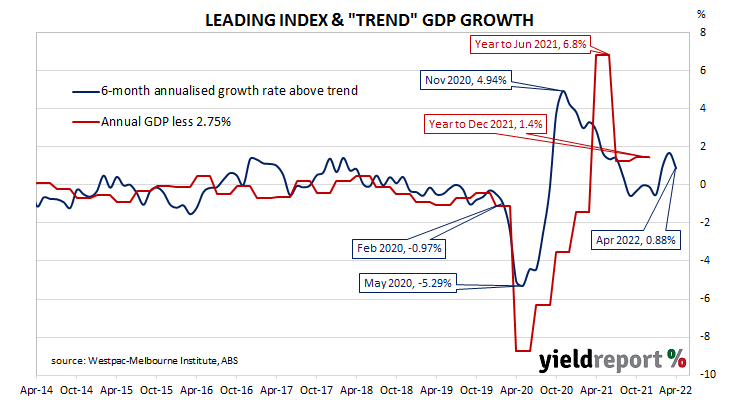Summary: Leading index growth rate down in April; large boost coming in June, September quarters; reading implies annual GDP growth of around 3.50% to 3.75%; Westpac expects “solid lift” in consumer spending but higher prices to constrain spending in real terms.
Westpac and the Melbourne Institute describe their Leading Index as a composite measure which attempts to estimate the likely pace of Australian economic growth in the short-term. After reaching a peak in early 2018, the index trended lower through 2018 and 2019 before plunging to recessionary levels in the second quarter of 2020. Subsequent readings were markedly higher but readings through 2021 mostly declined.
The April reading of the six month annualised growth rate of the indicator registered 0.88%, down from March’s revised figure of 1.69%.
“By holding comfortably above the zero level, the Leading Index is also consistent with above-trend growth in 2022 and a large boost coming in the June and September quarters,” said Westpac Chief Economist Bill Evans.
Index figures represent rates relative to “trend” GDP growth, which is generally thought to be around 2.75% per annum in Australia. The index is said to lead GDP by “three to nine months into the future” but the highest correlation between the index and actual GDP figures occurs with a three-month lead. The current reading thus represents an annual GDP growth rate of around 3.50% to 3.75% in the September quarter.
Domestic Treasury bond yields moved higher on the day. By the close of business, the 2-year ACGB yield had added 3bps to 3.02%, the 10-year yield had gained 5bps to 3.49% while the 20-year yield finished 8bps higher at 3.83%.
In the cash futures market, expectations of the actual cash rate’s path over time remained largely unchanged. At the end of the day, contract prices implied the cash rate, currently at 0.31%, would rise to 0.575% in June and then rise to 1.425% by August. May 2023 contracts implied a cash rate of 3.355%, 305bps above the current cash rate.
Evan said he expects “a further solid lift in consumer spending as household savings normalises and more income flows through to spending.” However, he also noted higher prices will constrain spending in real terms


